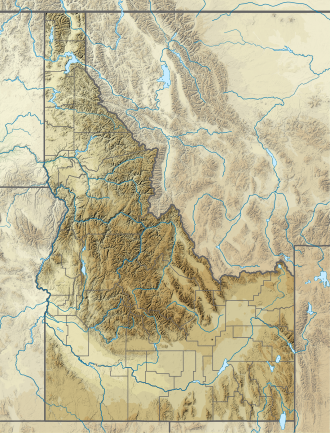Thousand Springs State Park
State park in Gooding County, Idaho, United States From Wikipedia, the free encyclopedia
Thousand Springs State Park is a public recreation and nature preservation area consisting of multiple units — Billingsley Creek, Earl M. Hardy Box Canyon Springs Nature Preserve, Malad Gorge, Niagara Springs, and Ritter Island — in Gooding County, Idaho.[2]
| Thousand Springs State Park | |
|---|---|
 Cliff with springs along the Snake River at Ritter Island | |
| Location | Gooding County, Idaho, United States |
| Nearest city | Hagerman, Idaho |
| Coordinates | 42°51′48″N 114°51′06″W[1] |
| Area | 2,000 acres (810 ha)[1] |
| Elevation | 2,800 ft (850 m)[1] |
| Established | 2005 |
| Administered by | Idaho Department of Parks and Recreation |
| Website | Official website |
Park units
Summarize
Perspective
The state park was created in 2005, when four existing state parks in the Hagerman Valley were merged into a single entity,[3] with an additional unit subsequently added to the complex.
- Billingsley Creek
This former ranch was purchased by the state in 2001.[2] One feature is the homesite of western author Vardis Fisher.[3] Billingsley Creek Unit totals 286 acres (116 ha).[4]
- Earl M. Hardy Box Canyon Springs Nature Preserve
This 350-acre (140 ha) box canyon has 250-foot-high (76 m) walls. At its head is the eleventh-largest spring in North America, gushing 180,000 US gallons (680,000 L) per minute.[4] There is a 20-foot (6.1 m) waterfall.[2] The 350-acre (140 ha) property was developed by the Nature Conservancy which purchased the site in 1999, then completed its transfer to the state in 2016.[5]

- Malad Gorge
Malad Gorge is a 250-foot-deep (76 m) canyon formed by the Malad River, downstream from a 60-foot (18 m) waterfall. This 652-acre (264 ha) day-use unit is off Interstate 84 and offers hiking and picnicking. A section of the Oregon Trail is visible.[2] Rock pigeons, red-tailed hawks and golden eagles nest in the canyon. Yellow-bellied marmots are found on the canyon floor.
- Niagara Springs
Proclaimed a National Natural Landmark,[6] this area borders the Snake River and features sheer basalt cliffs 350 feet (110 m) high.[4] There are 179 acres (72 ha) in two parcels, acquired in 1971 and 1976.[4]
- Ritter Island
This unit lies along the Snake River between two large springs.[2]
See also
References
Further reading
External links
Wikiwand - on
Seamless Wikipedia browsing. On steroids.


